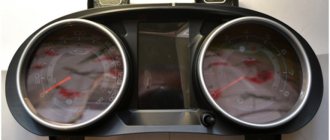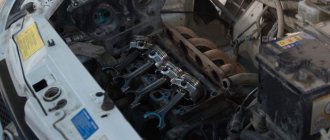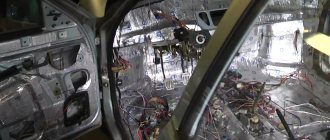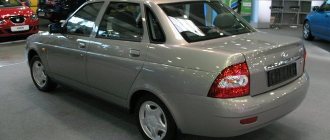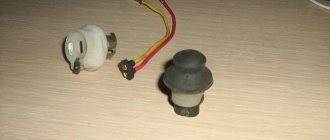In the summer, AVTOVAZ presented a new modification of the Lada XRAY Cross. Now this crossover is equipped with the Renault-Nissan H4m alliance engine (1.6 l, 114 hp) and the JF015E continuously variable automatic transmission (hereinafter referred to as “variator” or CVT). We found out how the car turned out during the test drive.
Design nuances
The 21179 engine bears little resemblance to the basic version 21127, as both the design and appearance have changed:
- phasing of intake valves within ±30 degrees;
- hollow camshafts with cams using powder metallurgy;
- vortex air supply into the combustion chamber;
- cylinder cooling system (jacket);
- improved configuration and cylinder head gasket volumes;
- ShPG Federal Mogul;
- Korean pump;
- inclined drilling of oil channels in the crankshaft journals;
- polymer cylinder head cover and solid aluminum pan;
- flywheel for clutch 215 mm, which is recommended by the manufacturer.
Motor gaskets
ShPG from Federal Mogul
Innovations Lada xray with VAZ-21129 and VAZ 21179 engines
Among the innovations that significantly separate the 129 engine from its predecessors, it is worth mentioning the presence of a technological intake system. For the first time in the history of AvtoVAZ, designers have developed and mass-produced intake manifolds with variable intake geometry. This system works as follows: at low speeds, air from the filter enters the engine along a long path, thereby ensuring optimal operation of the internal combustion engine. At high speeds, a mechanism installed in the manifold changes the path of air from the filter to the engine and sends it along a short path, thus achieving good filling of the cylinders even at speeds above 5000. This technological solution allowed engineers to “remove” an additional 8 liters from the engine. With. without serious intervention in the design of the cylinder head and cylinder block. The throttle valve has also changed; now, instead of the archaic cable mechanism, the throttle is controlled by an electronic gas pedal.
In addition to the technologically advanced intake manifold, the placement of the power unit has also undergone changes. Due to the use of the B0 platform, these engines began to be installed not on the body, through separate cushions, but on a subframe. True, advanced car enthusiasts did not greatly appreciate this design solution, since with this arrangement it is necessary to use additional xray engine protection.
What is this
Auto Electrics Diagnostics ICE Chip Tuning in Nefteyugansk Tel.
7-9222-58-19-42TOYOTA COROLLA 120 with 3ZZ-FE 1.6L 16V engine does not pull TOYOTA COROLLA 120, with automatic transmission and 3ZZ-FE VVT-i 1.6L 16V engine 2004 stalls, does not pull, chokes. Final conclusion Symptom An engine is usually understood as a unit that converts a certain type of energy into mechanical work. All cars are equipped with this spare part. If the motor fails, the machine will stop working. The engine not only ensures the movement of the vehicle, but also serves to operate the vehicle’s auxiliary systems (for example, air conditioning).
The power unit, regardless of type, is represented by the following components:
- Cylinder block.
- Piston rings.
- Piston.
- Crank mechanism.
If the motor fails, it is impossible not to notice it. Service station specialists point out the following signs of engine malfunction:
- Increased oil consumption.
- Reducing engine power.
- The engine will not start.
- Reduced compression in the cylinders of the power unit.
- Plumes of thick smoke appearing from the muffler.
- The smell of burnt rubber, motor oil, and fuel appears in the car dealership.
- The occurrence of extraneous sounds during engine operation.
The causes of power unit failure may be:
- Air filter dirty.
- Use of low quality fuel.
- Engine overheating.
- Engine operation with insufficient lubrication.
- The occurrence of water hammer in the cylinder.
Engine characteristics 21179
Engine oil test 0W40 API SLLUKOIL SYNTHETIC - reviews and expert testNORDIX PLATINUMADDINOL ULTRA LIGHT - reviews and expert testMOBIL SUPER SYN 0w40 - reviews and expert testSHELL HELIX ULTRA - expert reviews and testLUXOIL BRILLTEXBP VISCO 7000 - review
Initially, the plant management set the task of increasing the volume, so a standard boost was used - maintaining the cylinder diameter, increasing the piston stroke. The power drive 21127 used as a basis bends the valve, so version 21179 inherited this defect along with a high-life Gates belt to provide at least some guarantees against timing belt breakage.
The engine diagram remains the same:
- transverse, front-wheel drive;
- camshafts located at the top, 4 valves per cylinder.
Engine parts 21179
The developers have already made tuning in the engine:
- adding piston stroke;
- increasing the diameter of the valve while reducing the thickness of its rod to 5 mm;
- vortex supply of the air mixture into the combustion chamber.
Design Features
Despite the fact that the motor is lighter than previous versions, it uses large quantities of attachments, so overhaul and even normal maintenance on your own is a difficult task.
For example, the manufacturer provides for fixing the camshafts and crankshaft with special devices. To install them, he recommends removing most of the overhead and intake tract. Likewise, upgrading to increase power is also difficult since there is no free space under the hood.
Intake manifold Motor Super
As a result, the technical characteristics of modification 21179 are as follows:
| Manufacturer | AvtoVAZ |
| Engine brand | 21179 |
| Years of production | 2016 – … |
| Volume | 1774 cm3 (1.8 l) |
| Power | 89.7 kW (122 hp) |
| Torque moment | 170 Nm (at 3750 rpm) |
| Weight | 99.3 kg |
| Compression ratio | 10,3 |
| Nutrition | injector |
| Motor type | in-line |
| Injection | distributed electronically controlled |
| Ignition | electronic contactless microprocessor |
| Number of cylinders | 4 |
| Location of the first cylinder | TVE |
| Number of valves on each cylinder | 4 |
| Cylinder head material | aluminum alloy |
| Intake manifold | plastic manufacturer Motor Super |
| An exhaust manifold | catalyst |
| Camshaft | 2 pcs., marks on pulleys are offset by 2 degrees |
| Cylinder block material | cast iron |
| Cylinder diameter | 82 mm |
| Pistons | lightweight, manufacturer Federal Mogul |
| Crankshaft | from 11183 |
| Piston stroke | 84 mm |
| Fuel | AI-92 |
| Environmental standards | Euro 5/6 |
| Fuel consumption | highway – 5.8 l/100 km combined cycle 6.8 l/100 km city – 8.6 l/100 km |
| Oil consumption | maximum 0.2 l/1000 km |
| What kind of oil to pour into the engine by viscosity | 0W30, 0W40, 5W30, 5W40, 10W30, 10W40, 15W40 |
| Which engine oil is best by manufacturer | Liqui Moly, LukOil, Rosneft, Mannol, Mobil, Castrol |
| Oil for 21129 according to composition | synthetics, semi-synthetics |
| Engine oil volume | 4.4 l |
| Operating temperature | 95° |
| ICE resource | declared 200,000 km real unknown |
| Adjustment of valves | hydraulic compensators |
| Cooling system | forced, antifreeze |
| Coolant volume | 7.8 l |
| water pump | with metal impeller GBM |
| Candles for 21129 | BCPR6ES from NGK or domestic AU17DVRM |
| Spark plug gap | 1.1 mm |
| Timing belt | Gates, width 22 mm, service life 200,000 km |
| Cylinder operating order | 1-3-4-2 |
| Air filter | Nitto, Knecht, Fram, WIX, Hengst |
| Oil filter | catalog number 90915-10001 replacement 90915-10003, with check valve |
| Flywheel | increased damper size |
| Flywheel mounting bolts | box MT – M10x1.25 mm, length 26 mm, groove 11 mm box AT – M10x1.25 mm, length 26 mm without groove |
| Valve stem seals | code 90913-02090 inlet light code 90913-02088 exhaust dark |
| Compression | from 13 bar, difference in adjacent cylinders maximum 1 bar |
| XX speed | 800 – 850 min-1 |
| Tightening force of threaded connections | spark plug – 31 – 39 Nm flywheel – 62 – 87 Nm clutch bolt – 19 – 30 Nm bearing cap – 68 – 84 Nm (main) and 43 – 53 (rod) cylinder head – three stages 20 Nm, 69 – 85 Nm + 90° + 90° |
general information
On Lada Xray models, engines are available in three variations, but their general design is similar: gasoline inline four-cylinder units, with 4 valves per cylinder (16 valves in total) and two camshafts. True, this is where the similarities between the engines end. Considering the general characteristics of the Lada Xray, the engines installed on the model provide good power and torque, which is quite enough for everyday city use.
Let's take a closer look at which engines are equipped with x-rays and what are their main differences. However, before this it is worth mentioning that not all car models and trim levels are equipped with domestic power units. It will not be a secret for advanced car enthusiasts that new Lada models are created on the basis of the B0 platform. And since AvtoVAZ assembles models using Renault-Nissan technologies, many engineering solutions are borrowed from these manufacturers. The motor in this case was no exception, so AvtoVAZ installs the Nissan engine on the Xray in some trim levels.
Available body types
Largus owner reviews all cons
Reviews about the characteristics of the Lada Vesta create a pleasant impression. Many car enthusiasts have the feeling that we are not talking about the products of the more than once disgraced AvtoVAZ, but about a solid, brand new budget-class foreign car.
It is worth noting that at this stage the Lada Vesta sedan, the characteristics of which have already amazed the public, is the only mass-produced body type. AvtoVAZ facilities will be ready to produce a hatchback of this model by the end of spring 2016, and the model after restyling will undergo all kinds of test drives and will be released for sale only by the fall.
The best news is saved for last. The technical characteristics of the Lada Vesta station wagon promise to become something qualitatively different and superior to the capabilities of a sedan and hatchback. Information about the exact performance of this model is not yet available, but work on creating a Vesta of this type is already underway at the concern. It is worth noting that the plant management promises to make this station wagon a real crossover: the characteristics of the Lada Vesta will fully correspond to this title. According to experts, we should expect higher fuel consumption and more power from the standard engine that powers all-wheel drive, as well as independent soft suspension. In this case, the station wagon risks becoming a real pearl of AvtoVAZ, and such success can overshadow past failures. Unfortunately, it is currently not possible to find out anything about the characteristics of the Lada Vesta Cross, but the release of the crossover is planned immediately after the release of the hatchback.
Advantages and disadvantages
The advantages of the 21129 engine are:
- economical consumption of coolant, engine oil and fuel;
- compliance with Euro-5 standards;
- improved attachments;
- overhaul on your own;
- declared resource 200,000 km;
- absence of periodic adjustments of valve thermal clearances.
To ensure the specified motor life, the manual recommends using only high-quality lubricants from reliable manufacturers. The disadvantages of the power drive design are:
- expensive maintenance due to the need for high-quality oil in hydraulic pushers;
- high capital repair budget due to the use of ShPG and timing belt kits from foreign companies;
- there is a danger of bending the valves if the timing belt drive breaks.
The compression ratio has decreased by 0.5 units, which seems to reduce the octane number of the fuel. In practice, the quality of domestic gasoline is unsatisfactory; experts do not recommend experimenting for dubious savings in the operating budget.
Is there a difference in maintenance costs?
This question is much more important than it initially seems. Indeed, given approximately the same power, torque and minor differences in dynamic characteristics, many expect that the service price tags will be approximately the same. But it was not there! There is a difference and it is very significant!
In order to understand this, it is enough to simply calculate the total costs of undergoing scheduled maintenance of a LADA XRAY with a 110-horsepower H4M engine. As an example, it is reasonable to take a mileage of 90,000 km and prices at Moscow LADA dealership centers. In addition, it is immediately necessary to clarify that the service interval for the Nissan H4M engine and the domestic 106-horsepower unit is the same - 15,000 km. They can also be filled with the same oil from Rosneft.
There are no differences in the list of operations and components during the first 5 maintenance procedures – up to a mileage of 75,000 km. It is necessary to change the engine oil and filters (air, cabin and oil). The only difference is the price, since the components for a foreign motor are slightly more expensive than for a domestic one. In particular, the amounts for TO-1, TO-3 and TO-5 differ - for an X-Ray with a Russian engine, service will cost 5,900 rubles per visit, and for a hatchback with an H4M under the hood - 6,500 rubles.
The difference in the price for maintenance for X-rays with different engines is quite noticeable.
Everything is complicated by the situation with the spark plugs. Their replacement interval is indicated at 30,000 km, but not everything is so simple. For a VAZ engine, their cost is already included in the price of TO-2 and TO-4, which cost 6,400 rubles each. But owners of X-Rays with H4M units have to pay separately for both spark plugs and replacements. As a result, TO-2 and TO-4 cost 8,800 rubles each, and another 4,000 rubles for each of these TO will be spent on replacing spark plugs.
This cost is due to 2 factors:
- For the H4M, spark plugs from the NGK company are used, while for the Russian engine, spark plugs from Bosch, made in Russia (Saratov), are intended;
- Difficult to replace - to do this you have to dismantle the intake manifold and throttle.
The H4M engine requires expensive spark plugs, and changing them is not easy.
However, the greatest expenses await the owner of an imported engine after traveling the first 90,000 km, when the time comes for TO-6. For the owner of an X Ray with a Russian engine, this maintenance will cost 12,000 rubles, but the owner of a hatchback with an H4M engine will have to pay the dealer as much as 34,500 rubles (including spark plugs)!
The almost 3-fold difference in price is explained by the cost of the alternator belt and rollers. For a Nissan engine they are much more expensive than for a Russian one.
The result is not the most rosy, because for the first 90,000 km the owner of a Lada X-Ray with a domestic, 106-horsepower engine will need to pay a total of 42,500 rubles. But the costs of the owner of a LADA XRAY with an H4M engine will reach 79,600 rubles. The final difference is 37,100 rubles.
Convenience and speed
Lada Vesta is by no means considered the most comfortable car in its category - many foreign cars still surpass even the Luxury trim level in terms of their equipment. Another thing is that the ratio of price and characteristics of the Lada Vesta car makes this new brainchild of the AvtoVAZ concern a much more profitable purchase. In its price segment of budget cars, Vesta has no competitors: the price of the standard Classic configuration is a little over 500 thousand rubles, and the full Luxury configuration costs only a quarter more (625 thousand rubles) with functionality comparable to that of an expensive foreign car.
The trunk dimensions are quite impressive. It is very deep and very convenient, since the wheel arches of the body practically do not stand out inside the car. The working volume of the trunk is 450 liters - here Vesta also did not take the lead in its category, however, this figure is quite good.
As for speed, there is good news for those who like to drive. The technical characteristics of the Lada Vesta allow the car to accelerate to 185 km/h, while reaching 100 km/h in just ten and three tenths of a second. For a hatchback, naturally, slightly different aerodynamic conditions apply - however, its speed and acceleration will be quite good for a car in the budget price segment.
Is it a lot or a little?
Indeed, some will say that for 90,000 km you can fork out an extra 37,100 rubles. However, many will object. Still, LADA XRAY belongs to the budget segment, where not only the cost of the car itself is important, but also the cost of its maintenance. Other things - dynamics, sound insulation, etc. - are not looked at so closely.
In light of such expenses, there are fewer and fewer people disappointed that AvtoVAZ is discontinuing the X-Ray with a Nissan engine. In addition, the start of sales of a crossover with a 122-horsepower Russian engine will more than compensate for the loss.
The influence of wheel sizes on a car
Profile height
Low-profile tires combined with larger wheels give the car a more attractive (“aggressive”) appearance. In addition, less weight of the wheels will increase the car's handling and stability. But, given the disgusting quality of roads in most regions of Russia, it is impractical to install such tires - when hitting the sharp edge of a pothole in the asphalt, they easily break through. And so much so that even a disk can be damaged.
Tire width
Installing wider tires will increase the car's grip on the road surface, but if the latter is rutting, the car will be more difficult to control. This is especially dangerous in winter, on slippery roads. In addition, cross-country ability and controllability will decrease when driving on loose snow. Wide tires also create more noise when driving and cause increased fuel consumption.
Disc offset
Disc offset is the distance from the landing plane to the outer plane of rotation of the wheel. Here it is generally undesirable to experiment and install disks that have an offset equal to the factory one.
In addition to the fact that installing discs with an increased offset can limit the angle of rotation of the wheel, the load on the wheel bearings will also increase. In addition, when driving on an uneven road, the suspension travel will increase, which will negatively affect its service life.
And, in conclusion, we can say that choosing “tires” for a car is always a search for a compromise between its different indicators and characteristics, and it is important to be able to set priorities – what do you expect from the car and under what conditions will it have to “rack up the mileage”. Lada X-Ray is a roomy 5-seater hatchback, representing a class of pseudo-crossovers that is extremely popular in Russia.
In 2012, at the Moscow Motor Show, the XRAY Concept car made a real splash, setting a fundamentally new tone in the development of the style of the domestic brand. It was this that became the basis for the creation of the model, which also premiered in Moscow. AvtoVAZ made the right decision – the start of sales of the pseudo-SUV turned out to be extremely successful
Lada X-Ray is a roomy 5-seater hatchback, representing the class of pseudo-crossovers that is extremely popular in Russia. In 2012, at the Moscow Motor Show, the XRAY Concept car made a real splash, setting a fundamentally new tone in the development of the style of the domestic brand. It was this that became the basis for the creation of the model, which also premiered in Moscow. AvtoVAZ made the right decision – the start of sales of the pseudo-SUV turned out to be extremely successful.
The debate about the Lada XRAY class continues to this day. The model is made in a hatchback body (class B), but due to its higher ground clearance, some experts classify it as an SUV. The list of competitors for the domestic product is extensive. This includes both budget Renault Sandero Stepway, Geely MK Cross, and more expensive Mitsubishi ASX and Nissan Juke in comparison with X-Ray.
Reviews about the model
AvtoVAZ itself rates its own car quite highly. In particular, there is a competent setup of the chassis, which allows active maneuvering. An important role here is played by the front subframe and gas-filled shock absorbers, which provide traction on the surface. The energy intensity of the suspension, combined with high ground clearance and decent geometric cross-country ability, make it possible not to worry on the countryside and in the city. And the driver's position, cozy interior and excellent sound insulation complete the picture.
And the owners note in their reviews that a car equipped with an H4M engine causes practically no trouble. There are no problems with dynamics, it is also not noticeable in terms of noise, and the appetite is small - it usually does not rise above 9 liters even in a metropolis.
X-Ray has no problems with cross-country ability.
Do valves bend on Grant?
Since different versions of the Lada Granta are equipped with different engines (more about engines), the answer to the question above will be different.
On the “standard” trim levels, 8-valve 1.6-liter engines are installed, which are also used on the Lada Kalina. Such engines have already passed the test of time and have shown themselves to work well - even if the timing belt breaks, the valves remain in normal condition.
The “norm” configuration is equipped with a modernized 8-valve valve with a lightweight piston group (these are also installed on Kalina). Here the problem of pistons and valves meeting when the timing belt breaks has not been solved. This happens because special recesses are made in the pistons of such engines, and with the lightening of the ShPG, the pistons became thinner and there was no room left for the recesses.
The owners of the “luxury” will also not be able to please - their 16-valve valves also encounter a valve and piston when the belt breaks. True, there are fewer cases with such engines, but there is a risk. The main cause of breakage on such engines is jamming of the pump, tension and support rollers.
On modern VAZ engines, when the timing belt breaks, the valves “meet” the piston, which causes critical damage and requires expensive repairs. In this regard, AvtoVAZ decided to modernize its line of engines by installing new pistons that will eliminate such damage, writes CARscope.ru, citing its sources.
The plant's supplier, Federal Mogul, has mastered the production of pistons with recesses (holes, counterbores) in the bottom. Motors with such pistons are popularly called “plug-free”, that is, when the timing belt breaks, the valves do not “plug” into the pistons, the bottoms of which have special grooves for this case.
The new piston group is designed for a range of 1.6-liter engines that are installed on the Lada Granta, Kalina, Largus, Vesta, XRAY models:
- VAZ-11186 (8 cells, 87 hp)
- VAZ-21126 (16 cells, 98 hp)
- VAZ-21127 (16 cells, 106 hp)
- VAZ-21129 (16 cells, 106 hp)
For the 1.8-liter engine with the VAZ-21179 index, a modified piston group is not provided.
Update 08/29/18
: The day before the opening of MIAS-2018, AvtoVAZ representatives presented the updated Lada Granta family to the media. Now, on all Granta engines - both 8-valve and 16-valve - they use “stickless” pistons, that is, with grooves where the valve “falls” if the timing belt breaks, and the piston pushed up by inertia will go to it towards. Nikita Gladky (product manager) told Kolesa.Ru about this.
Update 09/04/18
: The website Lada.online clarified the information in the official LADA group on VK. Answer:
To the question “both Vesta and XRAY with 1.6 liter?” They answered like this:
Later, AvtoVAZ customer service reported:
Lada Largus also received such an engine modification, because This car is equipped with similar 1.6-liter engines.
Update 09/06/18
: A slide titled “Engine piston design change” has leaked online. It states that new pistons are used for all engines (only 1.6-liter engines are shown in the photo). The holes in the bottom of the piston for the full stroke of the valves eliminate the possibility of sticking the valves into the piston if the timing kinematics are disrupted (for example, if the belt breaks).
A new coating and a change in the side profile of the piston skirt made it possible to increase the wear resistance of the pistons and, as a result, reduce the tendency of engines to knock and increase fuel consumption.
Do you want to see this modification on 1.8-liter engines? This will happen if the brand “sees a clear request from the consumer,” who “has not yet expressed such wishes.” Simply put, if you want to get a “no problem”, write letters to the factory. This was reported to auto.mail.ru by Sergey Kornienko, head of the Lada brand product portfolio development department.
According to unofficial information, “stickless” pistons began to be installed from engine number 3920500.
Let us remind you that we previously published a comparison table of VAZ engines. According to a survey among users of the Lada.online website, it turned out that the 1.6-liter VAZ-21127 and VAZ 21129 engines are considered the most popular.
Dashboard
The front panel looks poor. The climate control unit is similar to Vesta. There is a joint: this panel breathes. We start the engine, but for some reason the instruments don’t come to life; we need backlighting. To see something on the instruments, you need to turn on the side lights. If nothing works, you can hardly see anything.
We compare with Vesta and Renault Logan or Sandero. My first thoughts were: yes, this is a VAZ, this is a Vesta, a new design. But from the first kilometers it becomes clear - this is Renault. A comfortable, quiet car that doesn’t make you want to drive fast, and doesn’t have that reckless handling of the Vesta. On the Vesta you want to drive fast, actively move, overtake, and take turns. Here you want to roll, drive at low speed. The stabilization system operates softly and smoothly, but cuts off traction.
This does not happen on Vesta; there we remain with a good supply of traction, even when the car begins to slide with the stabilization system working. Here everything should be calm, measured, smooth, that is, the ideology is more inherent in Renault cars, for which many people love these comfortable French cars.
They will probably love the Lada XRay too. Two weeks ago we tested all-wheel drive crossovers. The ditch was quite a difficult obstacle for them. Our Lada XRay car overcomes this ditch calmly.
Maintenance
The actual life of the internal combustion engine is still unknown due to the short service life of the first cars that rolled off the assembly line in 2016. However, to increase it, engine 21179 should be serviced according to the regulations below:
- 10,000 km means changing the filter/oil;
- twice as long, the alternator belt runs 30,000 km;
- after 45,000 km, change hoses/fittings and antifreeze;
- spark plugs and batteries are enough for 60,000 km;
- About 180,000 the original timing belt passes.
For 2022, the internal combustion engine device is considered the most advanced in the AvtoVAZ manufacturer’s line. In practice, his project had been considered since 2006, but was constantly postponed until the technical, economic and market situation in the Russian Federation finally developed favorably. That is, AvtoVAZ in this project prioritized the power output of the engine, and not economical fuel consumption, as was usually the case before.
What does the car look like
The car is pre-production, but is already being manufactured on the VAZ assembly line. Well assembled. Gaps in the hood and fender, headlights, how the chrome trim is attached. The quality of painting is also at a high level. Design is a subjective thing, but after I saw the face of this car, I want something original in the back.
At the rear there is such a rounded stern, with rather scanty lights. Surely you could put them on the trunk, but that would cost more money.
Plastic fender liners front and rear have tides. They are designed to reduce snow accumulation. The trunk can be opened using a button on the key or on the trunk door. The trunk is small, but has its own characteristics. Here is a floor that can be installed on two levels. Either put it down, then there will be more volume, or put it 8 cm higher, forming a large underground.
The shelf is made roughly and the geometry does not correspond to the plane, so it rattles a little on bumps.
Signs of the need for internal combustion engine repair
The reasons why the operation of the engine is disrupted are arranged in a small list, starting with refusal to start and ending with floating idle speed (this problem was removed on the 127 “engine”). Not all breakdowns end in capital damage - sometimes it’s enough to add oil, sometimes it’s enough to adjust the ECU settings.
Compression reduction
A decrease in cylinder compression below 16 atmospheres is a bad sign. Such a high limit corresponds to a compression ratio of 11.
Knocks in the engine
Engine knocks can come from several points. These could be hydraulic compressors, timing belt rollers or pins. The knocking noise could also be caused by low oil level. The answer to the question will be given by a thorough detailed inspection of all parts of the unit and checking the oil level.
Blue smoke from the exhaust pipe
The blue smoke that comes from the exhaust pipe appears when oil enters the combustion chamber. It can leak either from the valves or from under the piston. The result is the same: the oil is eaten up and blue smoke pours out of the chimney. Once the leak is located, half the problem will already be solved.
Troit motor
Sometimes in the cold the engine may stall - don’t be alarmed by this, because it may simply be one of the spark plugs that fails. In this case, we advise you to simply restart the engine and it will stop running.
How much does it cost to overhaul a Priora engine - average price
Self-repair of a Priora engine with 16 valves costs an average of 16-20 thousand rubles. The cost depends on the severity of the breakdown and may be lower or higher than this average range. Repairing a Priora engine can be entrusted to the wrong hands, but then you will have to pay for the work - sometimes the cost of repairs reaches as much as 40 thousand rubles.
This is an unreasonably inflated figure, because, as practice shows, you can rebuild the engine on a Priora, working at a moderate pace, in just three days - and three days of work is definitely not worth that kind of money. Don’t be afraid of not being able to cope - your Lada is easy to repair, and using the advice and “tutorials”, you will conquer even such a task that is impossible at first glance.
Of course, for many experienced car owners, the question such as “whether the valves on a Priora are bent” has long been studied. But there are many new drivers who do not have information on this matter. It is for such car enthusiasts that this post will be written.
Lada XRAY 2018-2019 owner reviews
Disadvantages of Lada X Ray 2018-2019
➖ Noise insulation ➖ Twitchy “robot” AMT ➖ Sensitive to ruts
pros
➕ Handling ➕ Good maneuverability ➕ Spacious trunk
All the shortcomings of the Lada X Ray 2018-2019 in the new body were identified based on reviews from real owners. More detailed pros and cons of Lada XRAY 1.8 and 1.6 with mechanics and AMT robot can be found in the stories below.
Reviews
A problem with VAZ assemblers - the front bumper on the left side near the headlight sticks out a little, as if it is not fully seated on the clip. The manager’s answer: “Yes, everyone does, from the factory, look at the others!
A classic automatic machine is still more comfortable than a robot. The bottom edge of the rear license plate frame with the car dealership advertisement rests directly on the trunk paint due to the sharp bends of the cover near the license plate. I'm afraid that in the future it will damage the paint due to vibration. I removed it and put the numbers without a frame.
All wheels were pumped up, with a pressure of 3.0 atm instead of the required 2.2 front and 2.0 rear. I didn't like the high beam.
zhivchik, review of Lada XRAY 1.8 (122 hp) AMT 2016
Video review
A robotic gearbox is not the best option; I used to have an automatic transmission. On an uphill, if it stops, the XRAY goes backwards. I always turn on the handbrake on the uphill and move off with the handbrake, otherwise I'm afraid to roll back and drive into the car that's behind me. At first the car shook and jerked at low speed - I was in shock, but now it jerks very rarely.
Elina Volkova, review of the new Lada X Ray 1.8 with AMT robot 2016
In essence, the Lada HREY is a passenger car with high ground clearance. I read somewhere about a very narrow pedal assembly, but it is quite sufficient for my size 43 feet. The gas pedal is located just below the brake pedal, sometimes the welt of the boot can cling to it, but in order to press both of them at once (as someone wrote), you need to wear felt boots.
I like the transformation of the X-Ray interior; it’s convenient that you can simply lower the back of the rear seat without lifting the sofa. The area is not perfectly flat, but it is acceptable for carrying additional luggage.
The driving position is comfortable. I raised the chair to the maximum height so that I could see the hood, this habit was passed on from the “Six”, where I placed a special pillow under the heel. Control ergonomics are acceptable. Some comments include the design of the side mirrors. More precisely, these are features that must be taken into account. The mirrors are slightly smaller than those of the Niva, but they have a great overview, because... they are slightly convex.
The 1.8 engine is much quieter than on the Niva. And in general, the cabin is quiet when driving. The engine pulls: in 5th gear on a flat road you can overtake at speeds from 80 to 100 km/h without shifting lower. In general, as I already wrote, acceleration is much faster than on Niva. At the same time, there are no hysterical howls of the transmission.
Nikolay Shishkin, review of Lada X-Ray 1.8 with mechanics 2022
At the moment I’m happy with everything except the AMT robot - before that I drove an automatic one. When switching from first to second, the engine spins up to crazy speeds - it’s a pity for the engine. Then at high speeds the robot gets confused and thinks for a long time. When driving in traffic jams, you let off the gas and the car starts to jerk. I found a way out - I turn on neutral and calmly roll up to the front car or stop line. On slight slopes when starting off, the rollback system does not work - it’s annoying.
My expansion tank burst. I called the dealership where I bought the car, and they told me to sign up for repairs, one by one. Wait a week, then the question is, how long will the repair itself take? You also have to pay for the tow truck yourself, and AvtoVAZ itself handles the refund. Question: when will the money be returned? And will they return at all? In general, I decided to change the tank myself. I asked for a reservoir and antifreeze - they gave everything without any problems, they said that they knew about the problem. One nut, two clamps, 10 minutes of time - problem solved.
Description of engines
All engines that were supposed to be installed on Lada Vesta cars are in-line 4-cylinder power units assembled practically according to the same scheme. They are equipped with a 16-valve DOHC gas distribution mechanism with two overhead camshafts. The sequence of cylinders is: 1-3 -4-2. The service life of each of these engines before the first major overhaul is no less than 200 thousand km.
Important! A common drawback of all VAZ engines, the gas distribution mechanism of which is driven by a belt - when it breaks, the valves bend.
However, despite the similarities, each of these power units has a number of differences:
- VAZ-11189 is part of the line of well-known VAZ engines: 21083/21114/21116/11186. It differs from the prototypes in the modified design of the intake and exhaust. The engine is the simplest and cheapest of the engines ever used on the Lada Vesta. Currently it is not installed on this model, since its technical characteristics turned out to be insufficient for a fairly heavy car.
- VAZ-21129 - installed on Lada Vesta cars from the first days of mass production to the present day. Can be combined with a robotic gearbox. It is an analogue of the VAZ 21127 engine, distinguished by the presence of a number of new components:
- Exhaust gas intake and exhaust system.
- Calibration controller for engine management and dynamic charging systems (the volume of the intake manifold can be changed using special dampers).
Modernization of the engine made it possible to reduce:
- Fuel consumption.
- Noise and vibration levels during operation.
- Exhaust toxicity.
VAZ-21179 is a new engine for the Lada Vesta. According to experts, it is most suitable for cars of this class.
The Lada Vesta engine differs from other power units:
- Increased cylinder capacity.
- New crankshaft.
- Torque 127 Nm at crankshaft speed 1000 rpm. In addition, the engine's gas distribution mechanism is equipped with the first domestic phase shifter. Due to experiments carried out with this phase shifter, the motor lay “on the shelf” for a long time. The appearance of a modification of the Lada Vesta car with a 1.8 liter engine. expected soon.
HR16DE-H4M is a motor developed by engineers of the Renault-Nissan alliance. Since 2005, its serial production has been mastered at OJSC AvtoVAZ. The Nissan Lada Vesta engine differs from domestic power units in a number of features, including:
- Installing the phase shifter on the intake shaft.
- Using electronic throttle.
- Availability of a variable valve timing system.
- Chain drive of the gas distribution mechanism.
The undoubted advantage of the engine is the ease of tuning, with which you can increase power and improve its technical characteristics. How to carry out tuning, what parts need to be installed, as well as the type of new firmware for the Lada Vesta engine can be found out by watching the video
https://youtube.com/watch?v=nV8-Wtmihb4
The disadvantages of the Lada Vesta engine include:
- The absence of hydraulic compensators for the valves of the gas distribution mechanism, which requires regular (on average every 90 thousand km) adjustment of thermal clearances during operation.
- Inability to install a robotic gearbox.
VAZ-21203 is one of the most interesting VAZ engines. Its prototype first appeared in 1998 and was intended for the Nadezhda minivan (VAZ 2120). Despite the fact that the car did not go into production, work on the 2-liter engine continued. Over many years of experimental work, it was possible to develop a number of non-standard technical solutions, which formed the basis of the new “well forgotten” motor.
The engine is versatile - it can be installed in both classic rear-wheel drive cars and more modern front-wheel drive ones. Serial production of the VAZ 21203 engine is expected to be carried out at the pilot production facilities of AvtoVAZ OJSC. The only obstacle that needs to be overcome during pre-production is that the life of the VAZ transmission is not designed to work together with a powerful power unit.
- Which car is the most powerful
- Differences in all-wheel drive systems, which is better?
- The ugliest car in the world
- Chinese fake cars
HR16DE and its features
This engine, which you can get with the new Lada X-Ray, has the same volume - 1.6 liters. But with a similar volume it has more power, which is 110 horsepower. HR16DE was developed for a Russian car by the friendly concern Renault-Nissan. It has proven itself on some models of these manufacturers and is widely known throughout the world. Therefore, we can say with confidence that the Lada Xray has a world-class unit. The new engine has a number of fundamental differences in relation to VAZ devices, which are equipped with cast iron blocks and conventional belts. The unit has an excellent reputation and promising technical characteristics. However, time will tell us which option is better.
HR16 is equipped with an aluminum cylinder block. The cylinder head is made of aluminum alloy. Instead of a timing belt, this device has a stronger and more durable metal chain. The engine is made without hydraulic compensators, but at the same time, it is equipped with a system for changing the gas distribution phases. Each cylinder has two injectors.
The HR16 engine is installed in the Lada X-Ray car in combination with a French gearbox from Renault. Based on reviews from car enthusiasts, we can conclude that the HR16 has excellent dynamics and works flawlessly. Engine characteristics:
- volume – 1598 cm3;
- has 4 cylinders, 16 valves;
- instead of a timing belt, a chain is used;
- the cylinder has a diameter of 78 millimeters;
- power – 110 hp
To reach a speed of one hundred km/h from zero, the Lada Xray will take 10.3 seconds. And the maximum speed is 171 km/h.
Size marking
For clarity, let’s read the inscription on the standard Lada XRay tire, for example: 195/65 R15. It means that the tire has the following dimensions:
- 195 – tire width in millimeters;
- 65 – tire profile height as a percentage of its width;
- 15 – disk size in inches.
The most incomprehensible quantity here is usually the profile height. In fact, it is not difficult to calculate it by converting it into understandable units: divide 195 by 100 and multiply by 65. The result is 126.75 millimeters.
It should be noted that low-profile “rubber” is considered if its height is less than 50% of the width. When independently choosing the size you require, keep in mind that a deviation of a value of up to 3 mm will not cause noticeable adverse consequences, and its value of 6 mm and above is simply unacceptable.
Design Features
Initially, engine 21129 retained the design of the basic version 21127:
- “tall” gray cylinder block, transferred from 11183, the surfaces of the liners are processed by honing;
- Cylinder head from modification 21124;
- gas distribution mechanism with phased injection with hydraulic compensation of thermal valve clearance;
- lightweight piston group from Federal Mogul;
- V-belt drive of timing camshafts with rounded teeth from Gates with a service life of 200,000 km;
- crankshaft with long radius crank from internal combustion engine 11183;
- fuel rail with medium-performance injectors from Bosch or Siemens;
- individual spark plug ignition coils without a high-voltage wire bundle;
- increased diameter of the damper on the flywheel;
- catalytic converter built into the exhaust tract - catalytic collector.
Engine Lada X-ray 1.6 liters
This power unit is an adaptation of the VAZ 21127 engine known from Priora to EURO 5, that is, a distant relative of the 21083 unit. There is, of course, an increased displacement, a new cylinder head with a pair of camshafts and hydraulic compensators, an intake tract of variable length, as well as an absolute pressure and air temperature sensor instead already outdated mass air flow sensor.
The main problems of this engine are the short service life of the pump, oil wastage, tripping when cold and often bursting coolant expansion tanks.
The Lada.online portal talks about the characteristic features of this internal combustion engine.
At first, the Lada Xray was equipped with a power unit from Renault-Nissan with the H4Mk index, well known from a number of models of the Franco-Japanese concern. This aluminum engine with a timing chain drive and a phase regulator on the intake shaft does not have hydraulic compensators, so it is necessary to periodically adjust the thermal clearances of the valves.
In the summer of 2022, the French-Japanese internal combustion engine with the H4M index returned to the model range due to the installation of the Jatco JF015E variator on the X-RAY. Its power was increased to 113 hp. and 152 Nm.
The list of typical malfunctions of this power unit cannot be called too long. The only things we can remember are problems with starting in severe frost, a slight waste of oil and a delicate ignition unit relay, as well as rapid wear of the engine mounts and the alternator belt.
| 1.6 l 21129 MKP5 | 1.6 l H4M manual gearbox5 | |
| Type | injector | injector |
| Fuel | gasoline AI-92 | gasoline AI-92 |
| Location | transverse | transverse |
| Cylinders | 4 in a row | 4 in a row |
| valves | 16 | 16 |
| Working volume | 1596 cm³ | 1598 cm³ |
| Power | 106 hp | 110 hp |
| Torque | 148 Nm | 150 Nm |
| Acceleration to 100 km/h | 11.4 s | 11.1 s |
| Speed (max) | 176 km/h | 181 km/h |
| Ecological Class | Euro 5 | Euro 4 |
| Consumption city | 9.3 l | 8.9 l |
| Flow track | 5.9 l | 5.6 l |
| Mixed flow | 7.2 l | 6.8 l |
The difference in maintenance costs for internal combustion engines of Renault and VAZ was calculated on the Auto.Vesti website
Possible internal combustion engine options for Lada X-Ray
Lada X-Ray has three engines that are offered to customers to choose from:
- VAZ-21129 - this option is used in the basic version of the Lada X-Ray and has a power of 106 horses;
- HR16DE – engine from foreign partners, is reliable and has 110 hp;
- VAZ 21179 is the most powerful engine of those installed on the Lada Xray, it has 122 hp.
All engines that are installed on the Lada X-Ray run on gasoline, and the most powerful version has a special VAZ automated manual transmission.
Cautions and Consequences
Valve bending on a Priora is mainly due to the piston meeting the first parts. If the timing belt breaks, the car owner cannot avoid expensive repairs. In such a situation, auto mechanics recommend:
- regularly check the condition of the belt,
- determine the presence of chips and cracks on the belt,
- check if there are any threads on the belt.
- remove the engine from the car,
- take it apart
- drain and replace oil,
- remove the crankshaft,
- remove the pistons
- remove the connecting rods.
In this case, you will also need to buy a new, lighter piston group. From an official dealer it will cost no more than 2-5 dollars. Some auto mechanics recommend buying a car of another brand, the price of which is practically no different from the cost of the Priora. It could be a KIA RIO or a Chevrolet Aveo. This problem can be solved using an optimized cooling system for the block and cylinder head.
Frequent timing belt breakage is associated with the use of low-quality automotive parts, including the idler pulley. To prevent such a breakdown, Priora car owners install the lower gear on the crankshaft, belt and rollers from the VAZ-2112 on their cars. In this case, the pump and gears on the camshaft do not change. Washers 5 mm thick are placed under the rollers. The presence of a large number of manufacturers of these parts allows you to choose high-quality and reliable products for cars.
The question is interesting and worries many - do the valves on a Lada Granta car bend when the timing belt breaks...
Xray with VAZ-21129 engine
Lada hrey with a VAZ-21129 engine cannot boast of serious power indicators. With the 129th engine, the car’s power is 106 hp. at 5800 rpm, and torque is at 148 Nm at 4200 rpm. For the modern market these are very mediocre indicators, but despite such characteristics the car turned out to be more or less reliable compared to the version with the 179 engine. AvtoVAZ testers set the maximum speed mark on the track at 172 km/h, and the maximum is determined by electronic restrictions and the design of the gearbox. Advanced car enthusiasts know that they can overcome this mark by flashing the ECU, cutting out catalysts and replacing camshafts, but is this necessary for the average user? The car travels its 130-140 km calmly and confidently; of course, parasitic noise appears in the cabin, but this is due to the general sound insulation, and not to the engine.
Vesta S-line and R versions
The Rospatent register recently included information about the trademarks and names of two new modifications of the Lada: the charged version of the Vesta R, as well as the S-Line, distinguished by the presence of sports styling on the body. Interestingly, the manufacturer plans to use an individual logo for each of these modifications.
Factory styling and S-Line will include interior modifications, installation of a spoiler, designer wheel rims and door sills and bumpers. It becomes logical that Vesta R will present that same VAZ “lighter”, which has equipment that seriously distinguishes it from the serial version.
There is information that for the R-modification of Vesta they will offer two powertrain options. One of them – a 1.6-liter, borrowed from Kalina NFR and producing 140 “horses”, will become the base one. Perhaps they will also equip the S-Line. The second is boosted to almost 150 hp. VAZ turbo 1.8-liter engine series 21179. In addition, it may turn out that its power will be increased to 180 hp.
Along with a powerful engine, Vesta R will receive a modified transmission, sports suspension and a braking system with increased efficiency.
Xray with VAZ engines
AvtoVAZ decided to please potential X Ray buyers and released several new engine models:
- VAZ engine with index 21129;
- VAZ engine with index 21179.
Let's look at these Lada X-ray engines and figure out which one is better, more reliable and more economical. So, the origins of power units 21129 and 21179 begin with the release of VAZ models of the 10th family. The general design of the engines has not changed much since then: displacement from 1.4 to 1.6 (and for 1.8 on unit 179) with 4 valves per cylinder and two camshafts, timing mechanism - belt, fuel type - gasoline.
With each new VAZ model, engineers refine these engines, trying to find the optimal balance of power and reliability. Since there are no fundamental changes in their design, in terms of maintainability, everything is excellent with these motors. Now on the market there is simply a myriad of parts for these power units.
